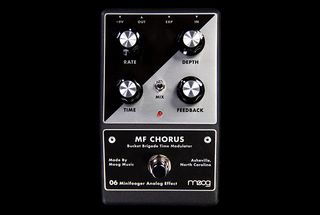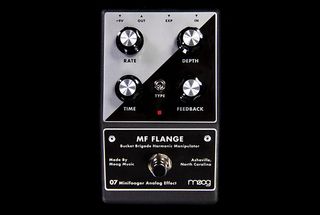Moog announces new Minifooger Chorus and Flange pedals
There's also a new look for the entire range
Moog has expanded its family of Minifooger analogue effect pedals with the MF Chorus and MF Flange. What's more, all the pedals in the range now have a new look.
The MF Chorus is first out of the blocks - indeed, it's shipping now - and is described as a BBD-based time modulation pedal. It comes with mono and stereo output modes and costs $209.
MF Flange, meanwhile, will be available in June, and is a BBD-based harmonic manipulator that can switch between vocal and traditional flange modes. Again, the price will be $209.
As before, all the Minifoogers are hand-built at Moog HQ, come with cast aluminium enclosures and feature a 100% analogue signal path. There's also true bypass switching, optional battery powering, and a single expression pedal input that enables hands-free control over one specified parameter within each unit.
Find out more about both of the new pedals below and on the Moog website.

Moog MF Chorus control/feature overview
- TIME: Minimum position is perfect for vibrato and bright chorus, while mid position shifts the tone to a deep choral motion. At maximum position, beautiful modulated slap delay is achieved.
- FEEDBACK: At low settings this control adds a slight resonance to the motion of a sound. At mid position, a more focused peak is created, and at maximum position with Time set to maximum - slap delay with beautiful echoes is achieved.
- MIX: In the down position the chorus sound is open and natural. At middle position the sound becomes thick and warmth is increased. In the up position (Vibrato) position, only the wet signal is heard.
- DEPTH: Determines the amount of modulation applied to the delay time. As this control is increased, the motion transforms from subtle vibrato to chorus, and then into multi-octave time modulation.
- RATE: Specifies the rate at which the LFO (Low Frequency Oscillator) modulates the analog delay time. Slower settings area ideal for large classic sweeps, while faster settings create spinning, rotary and film projector effects.
- EXPRESSION PEDAL INPUT: This input is assigned to the Rate control. Use it to sweep from slow shifts to chopping musical extremes. With Rate set to maximum, audio rate modulation is possible.
- MONO/STEREO SWITCH: To access both outputs (in bypass), you will need to remove the bottom of the MF Chorus and set this switch to Stereo. Then use a ¼" TRS to TS insert cable or TRS to TS splitter.

Moog MF Flange control/feature overview
- RATE: At Minimum position sweeps are gradual and fluid. As rate is increased, the movement becomes tighter and more focused. At maximum position, the modulation sound becomes is rapid and transitions to hard, percussive pulsing.
- DEPTH: Determines the amount of modulation applied to the delay time. As depth is increased, the sound transitions from light motion and phasing all the way into massive multi-octave sweeps.
- TIME: At maximum position you can easily craft traditional or vocal, metallic flange sounds. As the Time control position is reduced, delay time is increased and sounds become thicker and warmer. At Minimum position, the MF Flange is capable of approaching analog chorus.
- FEEDBACK: This control brings focus and resonance to the sweep of a sound. At minimum position, sweeps are smooth and neutral. At medium position, sweeps begin to peak musically. At maximum position, the sound of a sweep becomes rigid and metallic.
- TYPE: The lower position subtracts feedback from the input signal mixer and output dry signal creating a more vocal sound. In the Upper position, feedback is positively summed with the input signal and dry signal, producing a more traditional flanger sound.
- EXPRESSION PEDAL INPUT: This input is assigned to the Time control. Use an expression pedal to manually sweep through the delay frequency range of the MF Flange.
- MONO/STEREO SWITCH: To access both outputs (in bypass), you will need to remove the bottom of the MF Chorus and set this switch to Stereo. Then use a ¼" TRS to TS insert cable or TRS to TS splitter.
- WARNING: When set to Stereo and in bypass, excessive loading may occur. To avoid this, set this switch to Mono. A stereo output will still be present.
Get the MusicRadar Newsletter
Want all the hottest music and gear news, reviews, deals, features and more, direct to your inbox? Sign up here.

I’m the Deputy Editor of MusicRadar, having worked on the site since its launch in 2007. I previously spent eight years working on our sister magazine, Computer Music. I’ve been playing the piano, gigging in bands and failing to finish tracks at home for more than 30 years, 24 of which I’ve also spent writing about music and the ever-changing technology used to make it.

“It's transparent when not in operation, crisp when looping, and handles high-gain and complex audio sources with ease”: TC Electronic Ditto 2 Looper review

“Instead of pairing a new booster inside this new pedal, think of it as changing lanes inside the pedal”: Mythos and That Pedal Show team up for the Argo Boost Deluxe – an octave fuzz with a switchable boost




![Chris Hayes [left] wears a purple checked shirt and plays his 1957 Stratocaster in the studio; Michael J. Fox tears it up onstage as Marty McFly in the 1985 blockbuster Back To The Future.](https://cdn.mos.cms.futurecdn.net/nWZUSbFAwA6EqQdruLmXXh-840-80.jpg)






